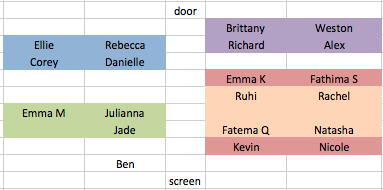Visual Unit Criteria and Stretch Goals
Work to have done:
- Work on your visual arguments, and push a rhetorical collage preview to GitHub: .xcf file, screenshot, and text description, plus updated list of assets/credits. Exported .png or .jpg optional but encouraged.
Plan for the Day:
- Reflective writing (5 min)
- Refresher on visual arguments we’ve liked (5 min)
- Gathering criteria (45 min)
- Sources, assets, permissions, citations (5-10 min)
- EXT: Studio and microconferences
1. Reflective writing (5 min)
2. Refresher on visual arguments we’ve liked (5 min)
Shift now in your writing to think about the blog posts on rhetorical collages in the wild – or, if you haven’t read through them in a while, look at them quickly now with an eye toward what people are praising in these images: what seems to make a visual design work well, especially for making some intervention in the world or the viewer? Jot down some notes.
3. Gathering criteria (45 min)
Primed now by that writing and thinking, I’m going to ask you to get in groups and brainstorm in pursuit of baseline and aspirational criteria for this unit.
3a. Let’s try the groups we used last time:

3b. Crowdsource ideas (10 min)
To bring all our notes together while allowing for real-time collaboration, use this google doc: bit.ly/cdm2019fall-criteria.
3c. Discuss and Integrate (30 min)
Quickly read through the other groups’ notes, adding comments in the margins to upvote or propose modifications. As you see consensus forming, propose an official version for our list of shared criteria.
We’ll refine as a group, and repeat, and then come back and revise after Tuesday’s workshop.
For next time:
- Work to bring in a full draft: a solid attempt at a complete visual argument, ideally meeting baseline criteria. Rough edges are still welcome.
- Continue taking periodic screenshots and posting meaningful commit messages in Git
- Push a full draft, with the same four parts as the preview plus a SOURCES.md file crediting your sources and permissions/license to use them
- NB: I’m only suggesting all-caps for special files readers might want to find quickly. It kind of loses the effect if everything is in caps. (Better to be all lowercase, if you have to choose.)
- Whether Box or GitHub, double-check that you can open the file: try downloading it into a different location. If it doesn’t open with all the layers you’d want, try saving the project again. (You may have exported the first time.)
-
Bring a camera (phone is fine), to take photos of feedback received
- NB: If GitHub is giving you trouble, you can use Box instead. Just make sure that you…
- add a link to the Box folder at the top of your GitHub README.md file.
- grant me (or the whole organization, which is Pitt) Downloader or Editor permissions in the Box folder
- put all the same files in the Box folder as you would have in GitHub.